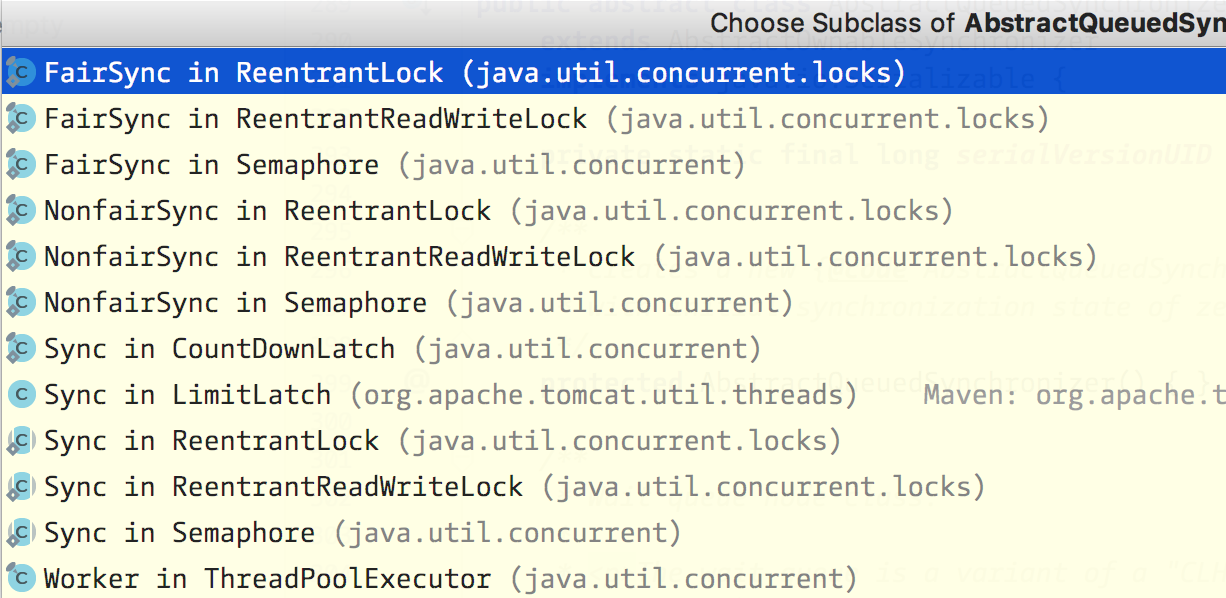AQS子类
继承于AQS的子类。
ReentrantLock
在ReentrantLock中的lock方法1
2
3public void lock() {
sync.lock();
}
就是对Sync类的调用。
锁的获取
大体的思路,就是先尝试获取一个锁,如果失败,说明锁正在被人占着,这时候需要把当前线程放到一个容器里,然后挂起。
下面看看具体的实现是啥。
如果是非公平锁1
2
3
4
5
6final void lock() {
if (compareAndSetState(0, 1))
setExclusiveOwnerThread(Thread.currentThread());
else
acquire(1);
}
在AQS类中有个state状态,用cas去改变他, 0代表空闲,1代表正在被占用。这个就相当于一个锁。1
private volatile int state;
如果state=0的话,代表当前锁没有被任何线程锁起来。
所以首先尝试获取这个锁,如果成功了,那么把当前的独占线程设为当前线程。
不然,调用acquire方法,加1。为什么加1呢,因为ReentantLock是可重入锁,同一个线程每一次获取都是加1,每一次释放就减1。下面我们会看到。
1 | public final void acquire(int arg) { |
acquire方法在AQS中。
但是tryAcquire是交给子类去实现的。
1 | protected final boolean tryAcquire(int acquires) { |
因为是非公平锁,所以调用nonfairTryAcquire。
1 | final boolean nonfairTryAcquire(int acquires) { |
在nonfairTryAcquire中,先再次尝试获取一下state。
如果失败,再判断下当前的独占线程是不是自己,如果是自己,就把acquire加上去。
这里就是可重入的逻辑。
如果获取失败,而且当前独占线程也不是自己,那么返回false。
再返回到AQS中的acquire逻辑,if中第一个条件失败了,那么执行第二个条件acquireQueued(addWaiter(Node.EXCLUSIVE), arg),就是把当前线程丢到一个等待锁的容器中并挂起。
Node的mode有下面这几种1
2
3
4
5
6
7
8
9//独占
static final Node EXCLUSIVE = null;
//这个线程取消获取锁
static final int CANCELLED = 1;
static final int SIGNAL = -1;
//这个线程在等待某个条件
static final int CONDITION = -2;
//节点唤醒需要向下传播,和读写锁有关
static final int PROPAGATE = -3;
上面调用的是独占的EXCLUSIVE。
1 | private transient volatile Node tail; |
看到node应该可以猜到这个放等待线程的容器是链表。
先cas尝试一下把当前线程包装的node放到末尾。
如果失败进入enq()中。1
2
3
4
5
6
7
8
9
10
11
12
13
14
15private Node enq(final Node node) {
for (;;) {
Node t = tail;
if (t == null) { // Must initialize
if (compareAndSetHead(new Node()))
tail = head;
} else {
node.prev = t;
if (compareAndSetTail(t, node)) {
t.next = node;
return t;
}
}
}
}
enq的逻辑就是不断自旋,cas加到末尾。其中也包含了head未初始化的情况。
好,现在成功加到末尾,调用acquireQueued方法。在这里进行挂起之类的操作。1
2
3
4
5
6
7
8
9
10
11
12
13
14
15
16
17
18
19
20
21final boolean acquireQueued(final Node node, int arg) {
boolean failed = true;
try {
boolean interrupted = false;
for (;;) {
final Node p = node.predecessor();
if (p == head && tryAcquire(arg)) {
setHead(node);
p.next = null; // help GC
failed = false;
return interrupted;
}
if (shouldParkAfterFailedAcquire(p, node) &&
parkAndCheckInterrupt())
interrupted = true;
}
} finally {
if (failed)
cancelAcquire(node);
}
}
node.predecessor得到的是节点的prev节点。
这里假设当前节点前面有很多节点,那么第一个条件肯定不满足,进入到第二个if中。1
2
3
4
5
6
7
8
9
10
11
12
13
14
15
16
17
18
19
20private static boolean shouldParkAfterFailedAcquire(Node pred, Node node) {
int ws = pred.waitStatus;
if (ws == Node.SIGNAL)
/*
* This node has already set status asking a release
* to signal it, so it can safely park.
*/
return true;
if (ws > 0) {
//表示前一个线程已经取消获取锁
do {
node.prev = pred = pred.prev;
} while (pred.waitStatus > 0);
pred.next = node;
} else {
//如果状态为0或者为PROPAGATE
compareAndSetWaitStatus(pred, ws, Node.SIGNAL);
}
return false;
}
判断前一个节点的waitStatus。
如果是SIGNAL,返回true
如果大于0,那就是cancelled了,那就跳过
不然就是cas把当前的pred的node的waitStatus设为SIGNAL
如果成功1
2
3
4private final boolean parkAndCheckInterrupt() {
LockSupport.park(this);
return Thread.interrupted();
}
那么parkAndCheckInterrupt就把当前线程挂起。
释放锁
在unLock中1
2
3
4
5
6
7
8
9
10
11
12
13
14
15
16
17
18
19
20
21
22
23
24
25
26
27
28public void unlock() {
sync.release(1);
}
protected final boolean tryRelease(int releases) {
int c = getState() - releases;
if (Thread.currentThread() != getExclusiveOwnerThread())
throw new IllegalMonitorStateException();
boolean free = false;
if (c == 0) {
free = true;
setExclusiveOwnerThread(null);
}
setState(c);
return free;
}
public final boolean release(int arg) {
if (tryRelease(arg)) {
Node h = head;
if (h != null && h.waitStatus != 0)
unparkSuccessor(h);
return true;
}
return false;
}
tryRelease方法,就是把state减掉,然后把当前的独占线程置空。
在回到release方法,那个unparkSuccessor调用。
1 | private void unparkSuccessor(Node node) { |
可以看到这里就是唤醒了下一个node节点中的等待线程。
那么ReentrantLock的公平和非公平体现在哪里呢。
我一开始以为的是head节点会唤醒所有的后缀节点,结果不是。
已经排队的节点还是按照排队顺序来唤醒。
不过在头节点唤醒时,可以有其他的线程来插队。
再回到lock方法1
2
3
4
5
6final void lock() {
if (compareAndSetState(0, 1))
setExclusiveOwnerThread(Thread.currentThread());
else
acquire(1);
}
在获取失败,加到队列的过程中,也尝试了两次插队,最后都失败了,才加入到队列中。
另外,AQS的等待队列只是FIFO的,也就是说不支持优先权。
总结
AQS为独占和共享提供了基本的接口,需要我们自己去实现tryAcquire等方法。
获取锁
正常来说,如果tryAcquire失败,那么AQS就会把当前线程包在Node中,加到等待队列中。
等待队列是一个FIFO的双向链表。
如果是独占的锁,那么就很简单,ReentrantLock就是借助一个int的变量表明被占用还是空闲。
如果是共享锁,这就要看具体的情况了,在CountDownLatch中,就是看当前的钥匙是不是0,如果不是0,说明还是有线程没有countdown,那就加到等待队列去。
在读写锁中,如果当前有读锁或者写锁,那就失败。
释放锁
然后每次head节点在临界区执行完成,就会选择唤醒下一个节点。
如果是独占的,就唤醒下一个,如果是共享的,那么就唤醒下一波所有的要获取共享锁的线程。
